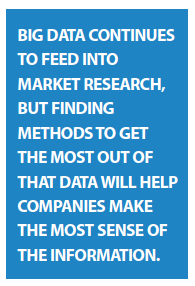The global pharmaceutical market was worth around $300 billion in 2015, according to the World Health Organization, and it is expected to surpass $400 billion by 2018 with a third of that value in the hands of the top 10 companies. But as the age of the blockbuster ends, pharmaceutical companies have had to develop new understandings of market trends, opportunities, and expectations. Market research is fundamentally about making use of the data and information available to gain insights and make observations to make strategic business and marketing decisions.
Big data presents pharmaceutical companies with opportunities to gain greater market insights, but at the same time adds to the challenges: with so much data it’s difficult to ascertain what is valuable and what isn’t. Companies need to find ways to use big data to enhance market intelligence, which is leading to a number of important trends, according to McKinsey. These include:
The rise of automation and artificial intelligence (AI)
Increased emphasis on competitive intelligence as integral to market intelligence
A move toward storytelling, persona development, and insight finding
Qualitative market research to answer the why
Behavioral economic principles and trends
Automation and Artificial Intelligence
 Digitization has started to sweep the pharmaceutical industry as companies tap into a revolution brought about by mobile capabilities, advanced analytics, and the Internet of Things. As McKinsey notes, pharmaceutical executives understand the disruptive potential of digital and are experimenting with a range of initiatives. In the area of market research, digital media are now a prerequisite and companies must embrace technologies that enable crucial insights into what works and what doesn’t from a commercial point of view. For example, a number of pharmaceutical companies have been tapping into mobile technologies to gain insights on physician prescribing preferences. In addition, gamification is being used more by market researchers.
Digitization has started to sweep the pharmaceutical industry as companies tap into a revolution brought about by mobile capabilities, advanced analytics, and the Internet of Things. As McKinsey notes, pharmaceutical executives understand the disruptive potential of digital and are experimenting with a range of initiatives. In the area of market research, digital media are now a prerequisite and companies must embrace technologies that enable crucial insights into what works and what doesn’t from a commercial point of view. For example, a number of pharmaceutical companies have been tapping into mobile technologies to gain insights on physician prescribing preferences. In addition, gamification is being used more by market researchers.
One important development is the area of automation and AI. According to a report from NewMR and GreenBook — Automation and Market Research: A journey, not a destination — automation in market research will continue to evolve and speed up, and has the potential to make things faster, cheaper, and potentially better. The authors predict that AI will have a significant impact on market research over the next five to 10 years, affecting such areas as qualitative research, research with images/video, and creativity.
Among areas where automation in market research is likely to expand are data collection, social media listening, and using apps for smartphone-based research. The NewMR report notes that in some instances automation enhances engagement. On example, is real-time tracking to make data gathering easier for participants, which leads to increased engagement. However, automation can make quality harder to assess, increasing the potential for making ill-informed choices.
AI has the potential to fill some of those gaps by tackling tasks that generally require human insight, and according the report, AI may overtake large parts of automation. Indeed, Deloitte expects a large increase in the number of commercial AI applications in the next three to five years.
Competitive Intelligence
Information is now just a click away thanks to the power of the Internet, but according to B2B International often some of the most important market research data — competitive intelligence — that can’t be found on the Internet.
Market intelligence, which is synonymous with market research, can be defined as “the information relevant to a company’s markets, gathered and analyzed specifically for the purpose of accurate and confident decision-making in determining market opportunity, market penetration strategy, and market development metrics.
Increasingly though, market researchers are seeking information on competitor strategies and approaches, such as sales data and production data. Equally, however, B2B notes that external views are highly valuable. Such information can be gleaned from press analysis and marketing analysis. Data from competitive intelligence can be used to determine another product’s side effect profile, contraindications, how effective a drug is and how well it is tolerated by patients, and general experience of the product on the market.
Pricing research is another element of competitor intelligence. This can be far more complex since it can extend beyond the price of a product to include intangible brand benefits. In pharma, this might include patient support programs or other initiatives.
Pharma companies need to glean such intelligence from as early in the development cycle as possible to make good strategic decisions about their products.
Storytelling and Persona Development
Creating a story or developing a persona for market research is important but extracting the data to develop that story can be difficult. According to customer research company Vision Critical, there are seven steps to defining a story. The first is to establish the framework, which is a systematic model to determine how data should be organized, analyzed, and linked to the business question and wider setting.
The next step is to create a big picture, such as how many brands in a particular therapeutic category are on the market, then step three is to find a strong story in the data, such as patient preferences. Step four is to have one key thread rather than multiple scenarios, and step five is about relevance, which means it’s important to link to the company’s major objective or concern. That requires identifying the audience’s assumptions and beliefs, and linking the story to those.
The sixth step is to determine the purpose, since the goal is to convey information that will let the company make better strategic decisions. The final step is to build on assumptions. An audience may have preconceived ideas about a category, so the idea would be to use those perceptions and build on them.
Another aspect to storytelling is persona development — a semi-fictional model to enable market segmentation. Again, data are the key to persona creation and using quantitative and qualitative data from multiple sources helps companies to understand motivations, behaviors, outlooks, and desired outcomes. The purpose of personas is to ensure programs are targeted to specific audiences by understanding those audiences. (See related box: Defining a Buyer Persona for Healthcare Marketing.)
Qualitative Market Research
Pharmaceutical companies have been tapping into big data to try to understand the needs and motivations of customers. But typically, such data is quantitative in nature and doesn’t provide insight into future opportunities and market expectations.
According to marketing experts, there will be increased emphasis on qualitative research in the coming years. These insights will be invaluable for uncovering both needs and opportunities to help companies make decisions about where to invest.
Increasingly, companies want to understand what their customers, or patients, are experiencing; they want to connect with these customers on an emotional and empathetic level; and they want to gain clear and relevant insights that affect their brands.
Helping this trend is the increase in the types of digital tools available. Although qualitative data analysis software (QDAS) has been around for more than 20 years, these tools are starting to gain greater acceptance among qualitative researchers, although mostly for data management and analysis. In particular, there has been an increase in the use of mobile for qualitative research as well as community-based discussion on social networks.
Behavioral Economic Principles
Behavorial economics combines insights from psychology and other social sciences with economic behavior. The actual decisions people make are often irrational, influenced by bias and context. To understand customer behavior, it’s therefore important to delve beyond the why — which qualitative research seeks to do — and to understand the other key elements: what, how, when, and where.
Where these aspects are particularly important in pharmaceutical market research is with tallying what customers say they do or prefer — the why — with what they actually do. Since people often don’t do what they say they are going to do, it’s important to develop market research studies that consider behavioral biases, such as choosing the familiar or allowing a single negative experience to outweigh positive experiences.
Methods to conduct behavorial economic research might include the use of mobile, gamification, and adopting certain qualitative and quantitative research methodologies. By understanding what drives human motivation and the biases people exhibit, it’s easier to assess the choices they are likely to make as well as how to change those biases. (PV)



















